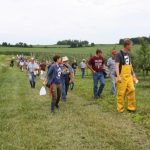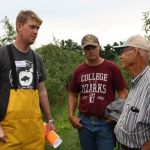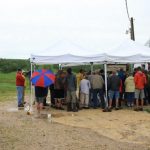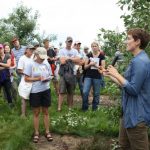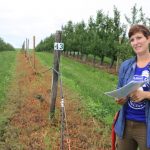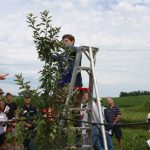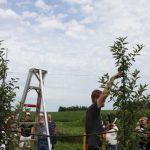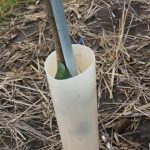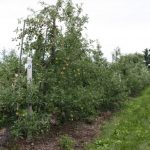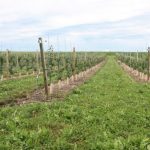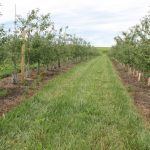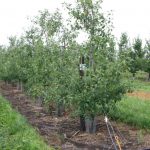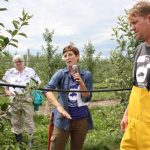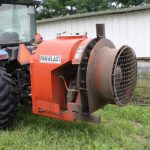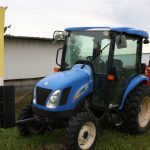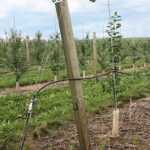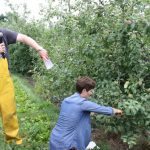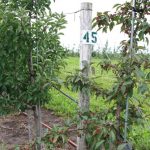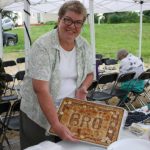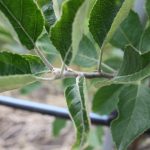Field Day Recap: Pruning and Management at Buffalo Ridge Orchard
On a thunderstorm-filled day, the skies cleared just long enough to let the trees dry for an orchard walk and summer pruning demonstration at Buffalo Ridge Orchard in Central City. Buffalo Ridge now has 3,600 trees, which were planted incrementally over the last seven years. They also raise vegetables, which cash-flowed the orchard infrastructure (they have not taken out any loans for the orchard). In addition to the dwarf apples, they have 2 acres of pears and 5 acres of vegetables, including two moveable high tunnels.
Emma and Marcus shared their year-round schedule for the orchard with field day attendees, which included tasks for the dormant season through harvest and everything between. All of their new trees are dwarfs, trellised on high tensile fence. They’ve used different methods of securing the trellis over the years, but now use an angled 4×4 post on the ends. They drip irrigate, with the tape running about four feet off the ground and the drip hole at each tree just outside the canopy. Keeping the tape off the grounds prevents problems with mice damage. Regular dog walks through the orchard serve as their rabbit and mice control.
Like all orchardists, the Johnsons are wary of frost events. Said Marcus, “there isn’t a lot you can do about the frost except take heartburn medicine and watch the thermometer, but we did buy a Frostbuster this year.” The frostbuster runs on 6 100-gallon propane tanks, and works the humidity in the orchard at the thermodynamic point of freezing, increasing the energy required to make the phase change from liquid to solid. Buffalo Ridge also has a weather station on their farm which was purchased from Cornell University, which provides modeling for a variety of orchard events, including frosts, bloom, potential disease and pest pressures, etc.
Their favorite new tool is a pair of Felco electric pruners. To Emma, these pruners will make orchard management physically sustainable in the years ahead. After the field day she gave us a quick demo cutting of some nearby sunflowers (video below).
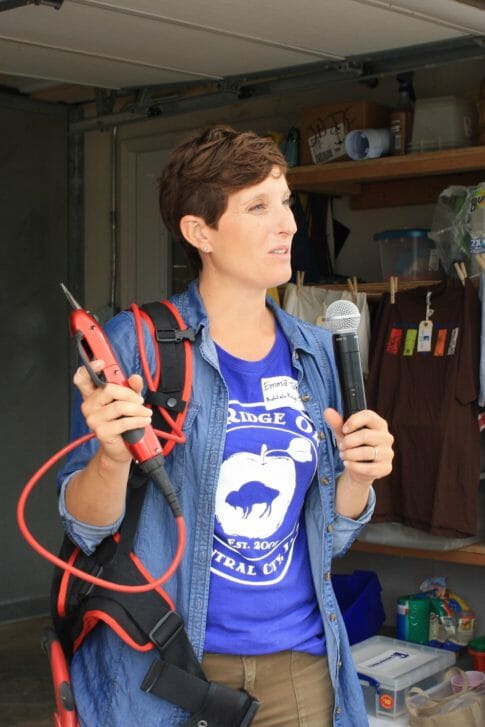
Emma with the Felco electric pruners
Because they have dwarf trees, summer and winter pruning are critical. Winter pruning helps stimulate branch production in the direction you want them to go; summer pruning, after terminal bud set, removes vegetative growth where you don’t want production. One of the most difficult tasks, mentally, is thinning fruit on the trees. The Johnsons like to keep 6 in. between most fruits, but for some larger varieties they will space them closer to reduce the size of each apple. “In our experience hand-thinning… we never thin enough. It feels like you’ve taken enough off, but in a month or two you’ll wonder why you left them so close together,” said Emma. Currently BRO spaces their trees at 6 ft on center. Emma noted that 10 years ago that would have been considered high density; now some high density orchards are planting on 2 ft centers. For the 2018 planting, they will plant 4 ft on center.
Following the orchard tour, some attendees toured the packing shed and walk-in coolers. Eventually everyone gathered under the tents for a potluck, enjoying the opportunity to continue visiting… even amidst the returning wind and rain!

